Uncovering the Charm of Dinosaur Fossil Decor
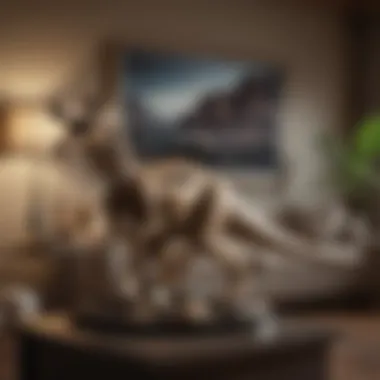

Intro
Dinosaur fossil decor captivates the imagination in a unique manner. The distinctiveness of this decor allows individuals to connect with ancient history while enriching their living spaces. This guide will explore the aesthetic appeal of dinosaur fossils, their cultural weight, and practical tips for integrating them into various environments. Understanding proper sourcing, preservation, and arrangement can allow anyone to enhance their home with these relics of the past.
Here, we aim to unravel the complexities related to selecting dinosaur fossils as decor items. This entails careful consideration of numerous factors, including style, historical context, and placement within the home.
Throughout this exploration, readers will discover how to not only beautify their spaces but also curate an environment that celebrates the grandiosity of the prehistoric world.
Featured Collectible of the Month
Overview
In the world of dinosaur fossil decor, one item often stands out: the Triceratops skull. This particular fossil draws attention not only for its size but also for its distinct features. The broad frill and striking facial horns make it an excellent conversation starter, suitable for various settings such as living rooms, offices, or museums.
Historical Significance
The Triceratops has long been a subject of interest among paleontologists. Believed to have roamed the Earth during the late Cretaceous period, approximately 68 million years ago, this creature provides insight into prehistoric life. Additionally, its fossils symbolize the triumph of evolutionary adaptations. Incorporating a Triceratops skull in decor does not merely serve aesthetic purposes; it acts as a bridge to understanding ancient ecosystems.
Identification Techniques
Visual Characteristics
Identifying dinosaur fossils requires an understanding of their unique traits. Fossils often exhibit:
- Texture variations, from smooth to rough surfaces.
- Distinct shapes relevant to specific species.
- Color patterns, which may change based on mineral composition over time.
All these features play a critical role in confirming authenticity and identity.
Resources for Identification
There are several reliable resources for those keen to identify dinosaur fossils accurately:
- Wikipedia: A good starting point for general knowledge and specifics about various species.
- Encyclopaedia Britannica: Provides extensive historical and scientific contexts.
- Reddit Communities: Engage with fellow enthusiasts who can provide tips and field experiences.
- Facebook Groups: Join specialized groups for direct interactions and shared experiences.
Proper identification ensures a proper appreciation for the fossils being integrated into home decor. Understanding their past adds depth to the decor and transforms spaces into vibrant galleries of history.
The Allure of Dinosaur Fossil Decor
Dinosaur fossil decor represents a unique junction between history, art, and personal expression. The pieces primarily speak to the curiosity surrounding dinosaurs that captivates numerous individuals. They evoke a sense of wonder, not only due to their ancient origins but also because they offer a tangible connection to a world long past. Homeowners increasingly recognize the potential of incorporating these artifacts into their spaces, blending aesthetics with educational value.
Historical Context
Understanding the historical context of dinosaur fossil decor is essential. Dinosaurs roamed the earth millions of years ago, and the study of fossils began in earnest during the 19th century. This period saw a surge in scientific interest as paleontologists uncovered and classified various species. As fossils were retrieved from the earth, they sparked public fascination not only with the creatures themselves but also with the epochs they inhabited. Thus, the allure of having dinosaur fossils in homes brings with it a narrative rich in discovery and exploration.
Cultural Significance
Dinosaur fossils hold significant cultural weight. They symbolize human curiosity and the quest for knowledge. In many cultures, dinosaurs are associated with childhood wonder, inspiring countless books, films, and educational materials. This pervasive interest fosters a sense of nostalgia. Collections of fossil decor often serve as conversation starters, linking the past to modern aesthetic trends. People often feel compelled to showcase these relics as they symbolize not just ancient life forms, but the shared human experience of discovery and learning.
Aesthetic Appeal
The aesthetic appeal of dinosaur fossil decor cannot be overlooked. These pieces offer a distinct visual element that can complement various design styles. Fossils can serve as striking focal points in any room. Their natural textures and forms provide an organic contrast to sleek, modern design. Additionally, the diversity of fossils—ranging from authentic skeletal remains to polished pieces—ensures that there is something to suit almost any taste. When placed thoughtfully, dinosaur fossils can enrich a space, transforming it into a curated environment filled with history and intrigue.
"Incorporating dinosaur fossils in decor is not just about aesthetics; it is about celebrating our shared history and fascination with the natural world."
The combination of historical context, cultural significance, and aesthetic appeal enriches the experience of engaging with dinosaur fossil decor, making it more than just a trend. It becomes a conduit for exploring the marvels of prehistoric life and an invitation to foster curiosity and appreciation within one's living space.
Types of Dinosaur Fossil Decor
Dinosaur fossil decor encompasses a wide range of items that can transform a space into a fascinating blend of history and aesthetics. The versatility of these decorations allows for unique expressions of personal taste, creativity, and a deep appreciation for natural history. Each type of fossil decor serves distinct purposes; from artistic elements to functional pieces. Understanding these categories and their implications can help an individual create an engaging environment that educates and enchants.
Wall Art
Wall art made from dinosaur fossils has the power to be both striking and educational. Fossilized images or representations of various dinosaurs can adorn walls and create focal points in rooms. When selecting wall art, consider the size and placement carefully. Large pieces can demand attention and anchor a room, while smaller artworks may complement existing decor. Incorporating framed fossil replicas or artistic renderings illustrates the ancient world's beauty, stirring curiosity.
Some decorative options include:
- Framed Fossils: Authentic fossils encased in glass frames, presenting a combination of artistry and scientific significance.
- Prints and Illustrations: Detailed images that provide insights into the appearance and environment of dinosaurs.
Table Displays
Table displays serve as engaging conversation starters and add a touch of the ancient to modern furnishings. Fossils can be used in various ways, whether placed on coffee tables, desks, or glass cases. When arranging these displays, think about height and balance. Use materials that complement each other to enhance the visual appeal. Consider the importance of light and reflection, which can bring out details in the fossils.
Some popular table decor items include:
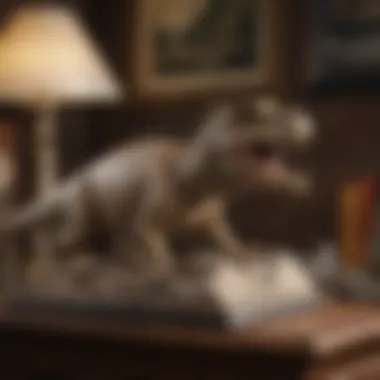
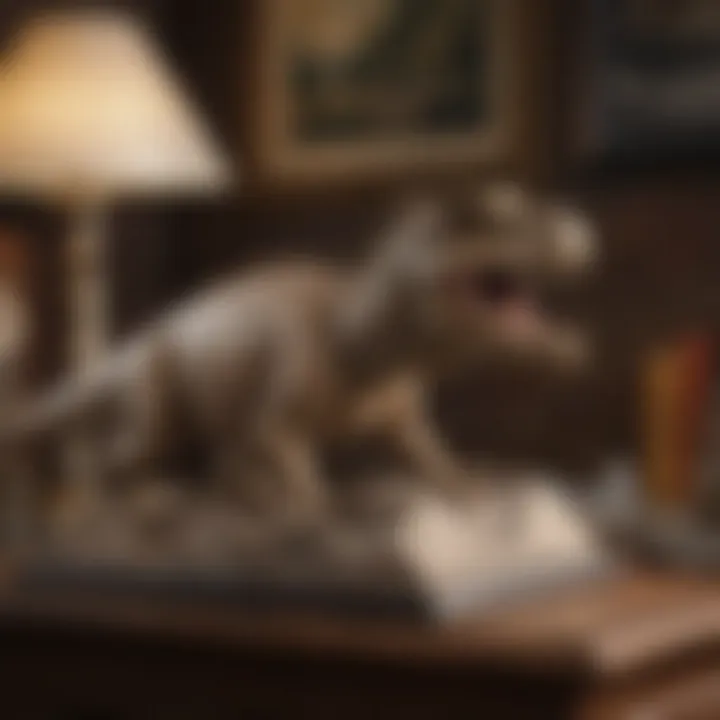
- Fossil Clusters: Grouping several small fossils can create an attractive vignette.
- Specimens Under Glass Domes: Display rare fossils this way to protect them while providing a closer look.
Lighting Fixtures
Lighting fixtures that incorporate dinosaur fossils present a unique twist on traditional illumination. Whether it's a lamp or chandelier, integrating fossils adds an element of wonder and history. Proper placement of these fixtures can enhance the overall atmosphere of a space. For example, a lamp with a base made from a fossil can serve as a centerpiece while casting warm light.
Considerations for choosing fossil lighting fixtures:
- Environmental Context: The style should fit well with the existing decor, whether it is minimalist, vintage, or eclectic.
- Material Quality: Ensure that the fossils are mounted securely. Quality fixtures enhance both safety and elegance.
Garden Features
Dinosaur fossils can also find a place in outdoor settings, merging natural beauty with history. Fossil-themed garden decor can enhance landscapes in various ways. From structures to standalone sculptures, these elements can contribute to a unique outdoor space.
Potential garden features include:
- Fossil Pathways: Using fossil replicas as stepping stones delivers a real connection to the past.
- Sculptures: Large dinosaur fossil sculptures can serve as statement pieces in gardens or parks, inviting curious onlookers.
In summary, the types of dinosaur fossil decor available provide ample opportunities for collectors and enthusiasts to create captivating environments. By thoughtfully selecting and arranging these elements, one can foster a deeper connection to the history encapsulated within fossils, while simultaneously enriching their living spaces.
Selecting Dinosaur Fossil Decor
The selection of dinosaur fossil decor is critical to creating a meaningful and aesthetically pleasing environment. It involves understanding the qualities that define a good piece, determining its authenticity, and considering its size in relation to your space. Each of these elements plays a significant role in the overall impact that fossil decor can have. Proper selection not only enhances visual appeal but also contributes to the narrative that your decor tells.
Identifying Quality Fossils
When deciding on dinosaur fossils for decor, the quality of the fossils is paramount. High-quality specimens often display unique characteristics that make them stand out. Look for fossils that show detailed textures and clear markings. These details are crucial for showcasing the intricate history of the specimen. You should pay attention to the preservation state as well; fossils that are intact convey a sense of authenticity.
Key aspects to consider when identifying quality fossils include:
- Clarity: Examine how well the features of the fossil are defined.
- Completeness: Ensure the fossil is largely intact, as missing parts can detract from its value.
- Coloration: Natural coloration often enhances the aesthetic appeal.
These elements will significantly influence the allure of your decor piece.
Evaluating Authenticity
The authenticity of a fossil is another factor that cannot be overlooked. With the rise in popularity of fossil decor, there are many replicas in the market. Authentic dinosaurs fossils not only carry more value but also enhance the credibility of your collection.
To evaluate authenticity, consider the following strategies:
- Documentation: Check for any certificates or provenance that accompany the fossil. This can establish its legitimacy.
- Expert Opinion: Consulting with paleontologists or fossil experts can provide insights into the fossil’s origin and authenticity.
- Physical Examination: Noticing the wear, patina and overall condition can also give clues to age and authenticity.
Creating a space with genuine fossils offers a richer experience, one that resonates with history and significance.
Sizing Considerations
Size greatly influences where and how a fossil can be displayed in your decor. The right size not only fits the spatial framework of your home but also enhances the fossil's aesthetic appeal. A large fossil can act as a focal point, while smaller pieces can complement other decor elements.
Points to think about when considering size include:
- Space Availability: Measure the area where you plan to place the fossil to ensure a good fit.
- Proportionality: Consider how the fossil relates to other objects or furniture in the space.
- Visibility: Ensure that the fossil is easily seen from various angles in a room, maximizing its impact.
Taking these factors into account will ensure that your dinosaur fossil decor serves both functional and visual purposes.
Incorporating Fossils into Design Themes
Dinosaur fossils offer a unique opportunity to blend the past with modern design. Their very nature encapsulates history and science, engaging a deeper appreciation of our planet's story. When incorporated into various design themes, fossils can serve not only as decor but also as conversation starters and educational tools.
Creating a cohesive look involves understanding how fossils interact with style, color palettes, and functional design. Their raw textures and organic shapes can enrich a space, providing depth and intrigue while maintaining a connection to nature. Let us examine how fossils can fit into different design styles.
Minimalist Interiors
In minimalist interiors, the mantra is to emphasize simplicity. Fossils can bring a subtle yet impactful element to this style. A single, well-placed dinosaur skull or a polished fossil can act as a focal point against neutral walls. The key is to choose pieces that do not overwhelm the clean lines and restrained color schemes typical of minimalism.
Benefits of using fossils in minimalist interiors include:
- A unique focal point: A well-chosen fossil can draw the eye and spark interest.
- Texture contrast: Fossils add a natural element that complements sleek furniture.
- Enhanced storytelling: Each fossil carries its own narrative, enriching the story of the space.
Eclectic Styles
Eclectic design thrives on variety and personal expression, making fossils an excellent choice for this theme. Here, fossils can be mixed with various materials, colors, and art forms. Combining a vibrant, colorful painting of a dinosaur with actual fossils creates a lively and playful atmosphere.
When using fossils in eclectic spaces:
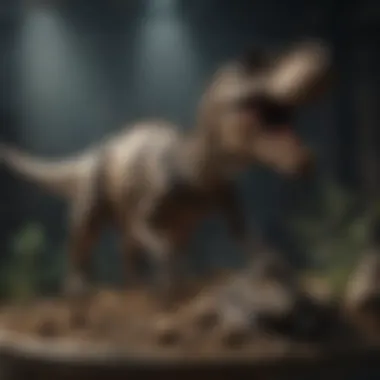
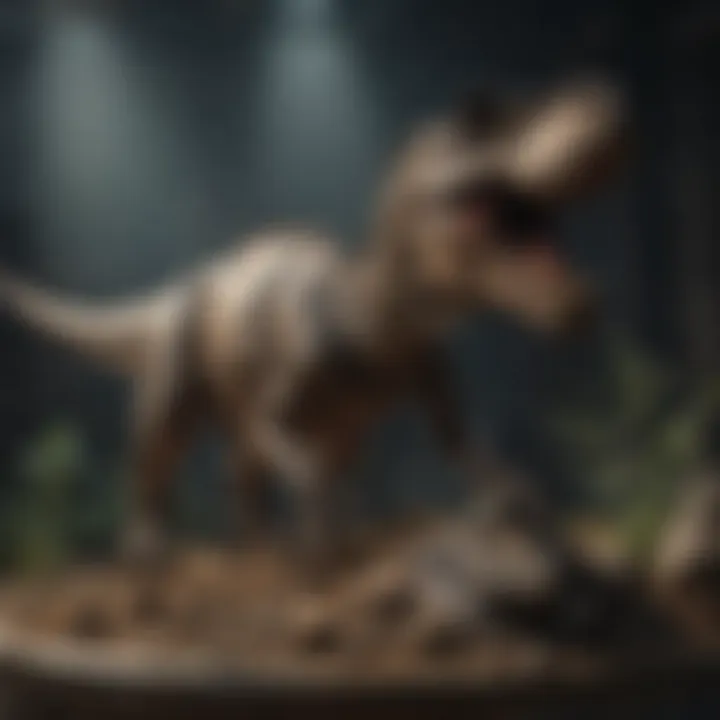
- Vary the size and type: Use a mix of small and large fossils from different species to create visual interest.
- Combine with other media: Pair fossils with handmade crafts or vintage findings for a curated and authentic look.
- Create layers: Utilize varying heights and textures in displays to keep the eye moving through the space.
Using fossils in design symbolizes a connection to both history and creativity, inviting visitors into a world of imagination and curiosity.
Natural Aesthetics
Natural aesthetics draw from the organic and unrefined beauty of the world, making them an ideal home for fossil decor. Incorporating fossils into this theme allows for a seamless transition between indoor and outdoor elements. Pieces can be showcased alongside other natural materials such as wood, stone, and greenery, enhancing the organic feel of the space.
Considerations for natural aesthetics:
- Integrate with plants: Placing fossils near indoor plants can soften their appearance and create a harmonious balance.
- Utilize earth tones: Complement fossil decor with earth-colored palettes to maintain a grounded vibe.
- Showcase the raw quality: Display fossils in their natural state, emphasizing their geological formation and age.
Care and Maintenance of Fossil Decor
Taking care of dinosaur fossil decor is essential for preserving its beauty and significance. Fossils are more than just decorative items; they are fragments of history. Proper maintenance ensures that these relics do not deteriorate over time. The benefits of upkeep extend beyond aesthetics. Well-maintained fossils retain their value and can even become focal points in a collection. This section will explore effective cleaning techniques, preservation methods, and long-term storage solutions, helping collectors fully appreciate and protect their investments.
Cleaning Techniques
Regular cleaning is vital for fossil decor, but it must be done with care. Each fossil type may require different approaches. Here are some cleaning methods:
- Dry Brushes: Use soft bristle brushes to remove dust. Avoid using stiff brushes that might scratch the surface.
- Moist Cloth Wipe: For soft materials, a slightly damp cloth can help remove grime. Ensure the cloth is not wet enough to cause any moisture damage.
- Mild Soap Solution: Mix a few drops of mild soap with water. Use it sparingly on fossils that are particularly dirty. Quickly dry them with a clean cloth afterward.
It is important never to use harsh chemicals or abrasive materials. Such products can significantly damage the surface and integrity of fossil decor.
Preservation Methods
Preserving fossil decor goes hand in hand with proper cleaning, but it requires additional considerations. Here are some methods to maintain the quality and value of your fossils:
- Temperature Control: Keep fossils in stable temperatures. Sudden changes can cause cracks and warping.
- Humidity Levels: Monitor humidity levels. Too much moisture can lead to mold growth, while too little can cause fossils to dry out and fracture.
- UV Protection: Display fossils away from direct sunlight. UV exposure can fade colors and degrade materials over time.
Adopting these practices ensures that each piece of decor remains vibrant and intact for years to come.
Long-term Storage Solutions
For collectors, long-term storage is critical when fossils are not on display. Several strategies can enhance the longevity of fossil decor:
- Use Acid-Free Boxes: Store each fossil in acid-free, sealed boxes. This prevents direct contact with harmful materials.
- Keep in Dry Conditions: Choose a storage space that is not prone to dampness, like basements or attics.
- Label and Organize: Clearly label boxes and keep an inventory. This will help locate specific pieces without unnecessary handling.
Investing in these storage solutions can prevent regrettable damage and maintain the integrity of your fossil decor over time.
Taking care of your fossils ensures they remain not just beautiful, but also a meaningful part of your home for generations.
Ethical Considerations in Sourcing Fossils
The topic of ethical considerations in sourcing fossils is critical to the overall discussion of dinosaur fossil decor. As interest in these ancient relics grows, so does the need for responsible and informed practices in sourcing and display. Not only does this ensure the preservation of significant archaeological and paleontological resources, but it also addresses the moral implications tied to collecting and displaying artifacts from the natural world.
When considering the integration of fossils into home decor, enthusiasts should prioritize legal and ethical practices to protect the integrity of the fossils and their origins. Collectors often grapple with the fine line between admiration for ancient relics and the potential harm to cultural and scientific heritage. Establishing a foundation of ethical sourcing fosters respect for both these artifacts and the communities from which they originate.
Legal Frameworks
Understanding the legal frameworks surrounding fossil collection is essential. Different countries have varied laws governing the ownership and sale of fossils, which can include bans on certain species or controls over excavation sites. Legal implications also extend to international trade agreements.
Before acquiring a fossil, individuals should research local regulations. This might involve questions such as:
- Is it legal to sell fossils in my country?
- Are there specific permits required for collection?
- What are the restrictions on certain species or types of fossils?
By adhering to these legal frameworks, collectors can avoid contributing to illegal trade and excavation practices that harm ecosystems and archaeological sites.
Sustainability Practices
Sustainable practices are another crucial element in ethical sourcing. The fossil collection process can have environmental impacts that are often overlooked by collectors. When sourcing fossils, it is beneficial to consider the preservation of ecosystems and the implications of fossil removal.
Practices to promote sustainability include:
- Responsible sourcing: Seek out reputable dealers who practice ethical sourcing of fossils. Ensure that fossils have not been taken from protected lands.
- Educating oneself: Understand the environmental impact of fossil collecting and advocate for sustainable practices.
- Supporting conservation efforts: Contribute to or collaborate with organizations focused on the preservation of fossil sites.
Fossil enthusiasts should not only be collectors but also stewards of the environment, working to ensure that the collection of these relics does not harm the natural world.
By adopting these sustainable practices, collectors can enjoy the beauty of dinosaur fossils while helping to preserve them for future generations. The ethical sourcing of fossils underpins the charm and educational value of fossil decor, making each piece not just a decorative element but a testament to responsible stewardship.
Trends in Dinosaur Fossil Decor
Understanding trends in dinosaur fossil decor is essential for enthusiasts and collectors alike. These trends reflect broader shifts in design, culture, and values. It is not merely about decorating a space; it also involves connecting with history and nature in a way that resonates with modern sensibilities. As dinosaur fossils become increasingly integrated into various decor styles, awareness of current trends allows collectors to make informed choices about what pieces to acquire and how to incorporate them thoughtfully into their environments.
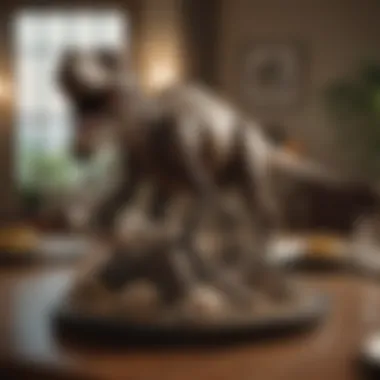
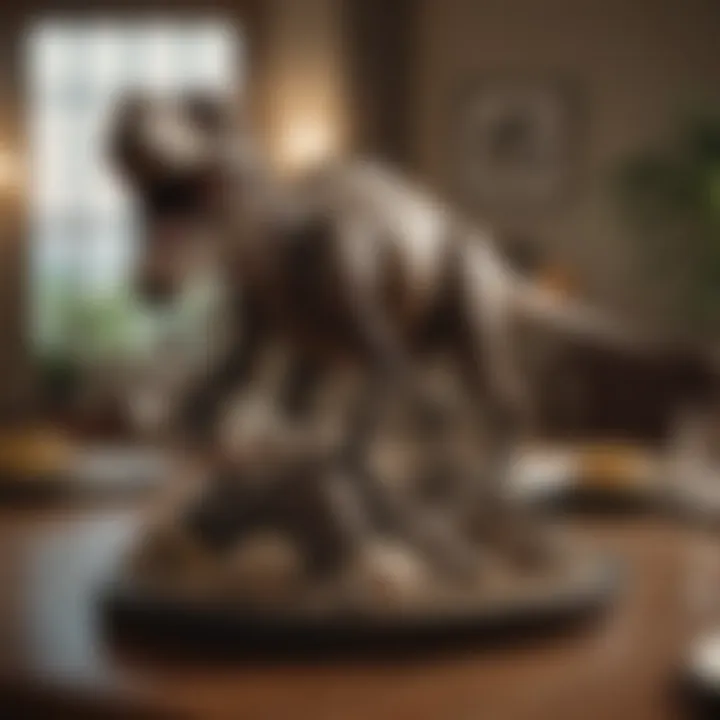
Urban Chic
The urban chic trend embraces minimalism and sophistication. In metropolitan settings, the use of dinosaur fossils serves as a perfect conversation starter. When integrated into sleek modern designs, fossils can provide a stark contrast to polished surfaces and sharp lines. Think about featuring a small dinosaur bone displayed on a sleek metal shelf or a fossil pendant light hanging over a dining table. This juxtaposition of ancient and modern reflects an appreciation for both the past and the present.
Additionally, urban chic often emphasizes functionality. Items like illuminated fossil displays or multi-purpose furniture featuring original fossil designs become appealing options for those living in smaller spaces. The combination of aesthetics and practicality is particularly recognizable in cities.
Vintage Revival
Vintage revival is a growing trend among collectors who seek nostalgia. There is an appeal in artifacts that connect us to times long past. Dinosaur fossils fit seamlessly into this aesthetic. The rich history and the story each piece tells make them ideal for vintage-inspired decor.
Displaying fossils in curated collections can make a room feel well-traveled and rich in character. Items like framed fossil prints paired with antique furniture capture the essence of vintage charm. The trend showcases the importance of storytelling in decor, allowing viewers to immerse themselves in a rich dialogue between pieces of the past and the interior spaces they inhabit.
It's fascinating how vintage aesthetics allow dinosaur fossils to resonate with collectors, not just as decor but as vessels of history.
The Rise of Eco-friendly Options
There is an increasing demand for eco-friendly decor, and dinosaur fossils can offer a unique avenue for sustainable practices. Collectors are now more conscious about the environmental impact of their purchases. Options like ethically sourced fossils and sustainable replicas made from recycled materials have become prominent. By choosing environmentally friendly alternatives, collectors can enhance their space without compromising their values.
"The movement towards eco-friendly decor isn't just a trend; it's a fundamental shift in how we engage with our environment and history."
Moreover, integrating fossils into biophilic design elements creates a more holistic experience. By bringing natural elements indoors, the trend fosters a sense of peace and connection to nature, essential in today’s urban settings. This aligns with a broader cultural movement towards sustainability and mindfulness, making it an excellent time to explore eco-friendly dinosaur fossil options.
Using Fossils in Educational Spaces
Incorporating dinosaur fossils into educational settings extends the appeal of these ancient relics beyond mere decor. Fossils can serve as powerful tools for enhancing learning experiences. They stimulate curiosity, foster engagement, and provide tangible connections to scientific concepts. In today’s rapidly evolving educational landscape, utilizing these items offers unique opportunities to cultivate minds eager for knowledge.
Classroom Applications
Fossils in the classroom can create dynamic learning experiences. Teachers can use fossil specimens to teach a variety of subjects, including science, history, and art. Here are specific applications:
- Hands-on Learning: Direct interaction with fossils engages students deeply. They can observe textures, shapes, and sizes, providing an engaging way to discuss paleontology.
- Interactive Projects: Students can create projects around fossils, such as fossil casts or reconstructions, enhancing creativity and teamwork.
- Real-World Implications: Discussing the formation of fossils brings in concepts about geology and Earth's history. It provides context for lessons in evolution and extinction, thus linking academic concepts to the world around them.
- Inclusion in Curriculum: Fossils can be integrated into various educational programs, from middle schools to universities. They offer endless opportunities for interdisciplinary studies.
Museum Displays
Using fossils in museums enhances public education and awareness. Museums often curate fossil displays to educate visitors about prehistoric life. Here are important elements of fossil displays in museums:
- Curatorial Expertise: Museums employ experts to select and arrange fossils for maximum educational impact. They must consider the scientific accuracy and the storytelling aspect of displays.
- Interactive Exhibits: Many modern museum displays include interactive elements, such as touch screens or digital overlays that provide detailed information about fossils and their contexts. This interactivity makes the educational experience more engaging for visitors.
- Public Programs: Museums often organize workshops and lectures that involve fossils. This allows the public to learn directly from experts about paleontology and related subjects.
- Collaborations with Schools: Many museums partner with educational institutions, providing access to fossil collections for school projects, thus bridging the gap between in-class learning and real-world applications.
"Fossils are more than remnants of the past; they are gateways into understanding our planet’s evolutionary journey."
In summary, both classrooms and museums can greatly benefit from the presence of dinosaur fossils. These spaces not only foster a deeper understanding of history and science but also inspire future generations to value the importance of paleontological research. By prioritizing fossils in educational environments, we cultivate a culture of curiosity and respect towards natural history.
Showcasing Your Collection
Showcasing a collection of dinosaur fossils is more than just a display of ancient relics; it is an opportunity to tell a story. Each fossil carries with it a unique history and a connection to the distant past. For collectors, the way fossils are displayed can significantly impact their appreciation and understanding by others. Also, a well-curated showcase invites curiosity, dialogue, and learning. It enhances the overall aesthetic of space while also serving as a rich source of information.
When it comes to showcasing, consideration of layout and context is essential. Properly displaying fossils can elevate them from static objects to dynamic conversation pieces. Whether one opts for a minimalist aesthetic or an eclectic approach, the arrangement can highlight the qualities of each fossil, drawing attention to their distinct features. Using accurate lighting and accompanying informational signage can help visitors engage with the collection on a deeper level.
Display Cases
Display cases are vital for preserving and presenting dinosaur fossils. They serve several crucial functions. First, they protect fossils from environmental factors such as dust, humidity, and direct UV light. Therefore, investing in high-quality cases is a must for any serious collector. The choice of material for the case should promote visibility while safeguarding against deterioration. Clear glass is often preferred as it allows unobstructed views while offering protection.
Additionally, when designing display cases, consideration of height and placement is critical. Fossils should be positioned at eye level to engage viewers easily. A combination of backlighting and highlighting techniques can enhance the fossils' features without overwhelming their natural beauty. An organized arrangement, perhaps by type or period, can narrate a natural history lesson to the audience.
Public Exhibitions
For enthusiasts interested in sharing their collection more broadly, public exhibitions offer exciting opportunities. Setting up a display in a local museum or community center can increase appreciation of fossil decor and foster a deeper understanding of paleontology among the general public. During exhibitions, educational programs can complement the display, allowing visitors to learn about the significance of fossils in Earth's history and the processes involved in their formation and preservation.
When planning an exhibition, logistical considerations play a key role. Proper transportation methods must be ensured to keep fossils safe and intact, especially if the collection is traveling. Prior discussions with venue management about security and conditions will help maintain an optimal display environment. Furthermore, marketing the exhibition through social media or local news outlets can help attract attention and ensure a wider audience engagement.
"Showcasing your collection not only enriches the space but also contributes to the community's understanding of our planet's history."
By thoughtfully showcasing dinosaur fossils—whether in personal spaces or for public exhibitions—collectors can create lasting impressions while preserving and honoring these ancient treasures.
Culmination
The exploration of dinosaur fossil decor reveals not only the aesthetic qualities but also the deeper connections to history and culture. This type of decoration provides an intersection of art and science, offering unique ways to appreciate ancient life forms in personal spaces. Integrating fossils into design is not merely about aesthetics; it fosters an appreciation for our planet's history and encourages educational discussions.
As we look forward, several elements emerge as significant in shaping the future of dinosaur fossil decor. The growing interest in sustainability and ethical sourcing amplifies the responsibility of collectors and decorators alike. A greater awareness of environmental impacts, combined with an appreciation for authentic fossil pieces, is vital. This leads to more informed choices that respect both the origins of fossils and the ecosystems they represent.
Future trends may involve advancements in technology, enabling more innovative display methods or interactive educational pieces. Enhanced visibility online can connect a wider audience to the charm of using fossils in everyday design. Collectors who share their insights on platforms such as reddit.com or facebook.com can create communities that celebrate both science and history.
Future of Dinosaur Fossil Decor
The future of dinosaur fossil decor appears promising, as interest in the intersection of natural history and interior design continues to rise. Here are some potential trends and considerations:
- Diversity in Sourcing: More collectors are likely to seek out ethically sourced fossils, emphasizing sustainability and authenticity.
- Innovative Display Techniques: Advances in technology may lead to more interactive and engaging display methods, appealing to a younger audience that values interactivity.
- DIY and Customization: The trend towards personalization will encourage individuals to integrate fossils in creative and unique ways, enhancing their environments.
- Community Engagement: Online platforms may host more discussions and exhibitions, allowing enthusiasts to share knowledge and showcase collections more effectively.
In summary, the future of dinosaur fossil decor will be shaped by the blend of appreciation for the past and innovative approaches to design. This combination provides a platform for both education and aesthetic expression, ensuring that the charm of these ancient relics continues to resonate into the future.



